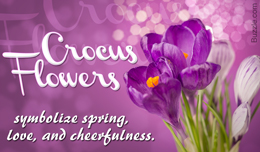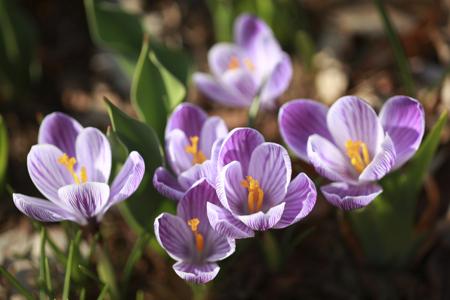





 Every year on the 6th of May the Turks celebrate the spring festival Hidrellez by preparing a special 'pilaf' made out of rice, wheat and crocus bulbs.The language of flowers was first formulated during the Victorian era and came to be known as floriography wherein each flower conveyed a specific meaning. The Crocus is a perennial spring flowering plant that grows from a corm primitively found throughout Europe and Asia.These delicate cup-shaped flowers bloom in lilac, mauve, yellow and white during the autumn-flowering and spring-flowering season of January in countries that experience cold and temperate climates. They significantly symbolize hope and cheerfulness during the end of winter with their vibrancy covering the foothills of cold and elevated mountains withstanding harsh icy winds thus representing floral resurrection and beginning of spring.
Every year on the 6th of May the Turks celebrate the spring festival Hidrellez by preparing a special 'pilaf' made out of rice, wheat and crocus bulbs.The language of flowers was first formulated during the Victorian era and came to be known as floriography wherein each flower conveyed a specific meaning. The Crocus is a perennial spring flowering plant that grows from a corm primitively found throughout Europe and Asia.These delicate cup-shaped flowers bloom in lilac, mauve, yellow and white during the autumn-flowering and spring-flowering season of January in countries that experience cold and temperate climates. They significantly symbolize hope and cheerfulness during the end of winter with their vibrancy covering the foothills of cold and elevated mountains withstanding harsh icy winds thus representing floral resurrection and beginning of spring. Crocus FlowerOrigin & Meaning✦ According to the Online Etymology Dictionary the name Crocus originated during the 14th century and is derived from the Greek word krokos meaning saffron. In Latin, it originated from the adjective crocatus meaning saffron yellow. Other names are karkom in Hebrew, kurkama in Aramaic, and kurkum in Arabic and Persian. The yellow etymology reasonably refers to the expensive Saffron spice obtained from the autumn saffron crocus which also produces a rich yellow dye. During Roman times, when Crocus sativa was grown in England for obtaining saffron it was known as croh.Symbolism✦ As depicted on a small 2000 B.C. slab in Hattusa, the Hittites who once lived on the Anatolian plateau celebrated spring festival on the arrival of the crocus flowers. The bulbs of these flowers were used in important spring rituals to appease the Gods. These species flowering during the onset of spring symbolize awakening of nature, floral revitalization, heavenly bliss, and nature's rebirth in the dead of winter.✦ During the 1500 B.C. Bronze Age in the Minoan Crete culture, women adorned crocus flowers in their hair and used saffron-based cosmetics for a glowing skin. These flowers were held sacred and also used for medical properties in the Egypt culture and are depicted in artifacts dating back to over 1600 BC. In ancient Rome, women used saffron to dye their hair and color their apparels in royal yellow. The yellow dye symbolized wealth, status, and royalty among the ancients.✦ Crocus popularly belonged to the cult of Ariadne, the goddess of vegetation on Crete and Thera islands. Very little is known about the goddess but Greek mythology states that she is reborn every year. Hence it could be associated to the perennial attribute of these flowers. Numerous ancient illustrations found on the volcanic island of Thera (Santorini) depict the Crocus Goddess celebrating a new phase of life carrying a large basket of blooms and surrounded by devotees wearing saffron-colored dresses. According to the paintings it is believed that young girls went out to pick the blossoms during spring and rendered it as religious offerings to the female deity. It also meant a phase or jubilant celebration of initiation into adulthood of young girls and boys hence the flowers also symbolize youthful energy, joy, renewal of life, blossoming of youth, and beauty. The paintings also depict the flowers ritualistically adorned on the vessels and other cult objects related to the Greek Goddess.✦ Such was the demand of a few pounds of crocus corms that they were used as loan for gold and jewelry during medieval European trade. The Victorian age termed the flower symbolic to the sun and affiliated it with qualities of cheerfulness, glee, mirth, and youthfulness. In numerology, it significantly stands for number eight and is related to the third-eye chakra of the human body.Famous Legends✦ There are three versions of the classic Greek mythology related to the mortal being Crocus. In one, the shepherd boy falls in love with beautiful nymph Smilax. The Gods are angered on their union and turn mortal Crocus into a flower and Smilax into Bindweed. On similar lines in another rendition the mortal being and the nymph's union receives approval from the Gods for their deep devotion towards each other and hence are transformed into an immortal flower and coniferous tree respectively. In another adaptation of the story Crocus is the companion of God Hermes and is accidentally killed during a game of discus. To mourn and honor his death, Hermes transforms his body into a beautiful flower.✦ The most famed legend associated with Crocus flowers as symbol of love is perhaps of the origination of Valentine's day. Valentinus was a 3rd century Roman physician and a devout Christian priest who administered his patients with natural remedies. He would also fervently pray for the people under his medical care. Unfortunately, Christian practices were prohibited under the reign of Claudius II, and Valentinus was arrested and condemned to death.The jailer's blind daughter was one of Valentinus's patients. Just before his execution, Valentine handed the jailer a note en-wrapped with a yellow crocus, the source of the healing herb, saffron. The vision of the jailer's blind daughter was miraculously restored on receiving the note and the first flower she saw was the yellow crocus. On the note, the Christian physician had penned his last message: From your Valentine. This was the world's first valentine message and the day was 14th February, 270 AD thus started the tradition of love.From the seat of divinity to the echoes of eternal love, these flowers stand for perennial happiness and inspire love like Cupid's heavenly arrows.
Crocus FlowerOrigin & Meaning✦ According to the Online Etymology Dictionary the name Crocus originated during the 14th century and is derived from the Greek word krokos meaning saffron. In Latin, it originated from the adjective crocatus meaning saffron yellow. Other names are karkom in Hebrew, kurkama in Aramaic, and kurkum in Arabic and Persian. The yellow etymology reasonably refers to the expensive Saffron spice obtained from the autumn saffron crocus which also produces a rich yellow dye. During Roman times, when Crocus sativa was grown in England for obtaining saffron it was known as croh.Symbolism✦ As depicted on a small 2000 B.C. slab in Hattusa, the Hittites who once lived on the Anatolian plateau celebrated spring festival on the arrival of the crocus flowers. The bulbs of these flowers were used in important spring rituals to appease the Gods. These species flowering during the onset of spring symbolize awakening of nature, floral revitalization, heavenly bliss, and nature's rebirth in the dead of winter.✦ During the 1500 B.C. Bronze Age in the Minoan Crete culture, women adorned crocus flowers in their hair and used saffron-based cosmetics for a glowing skin. These flowers were held sacred and also used for medical properties in the Egypt culture and are depicted in artifacts dating back to over 1600 BC. In ancient Rome, women used saffron to dye their hair and color their apparels in royal yellow. The yellow dye symbolized wealth, status, and royalty among the ancients.✦ Crocus popularly belonged to the cult of Ariadne, the goddess of vegetation on Crete and Thera islands. Very little is known about the goddess but Greek mythology states that she is reborn every year. Hence it could be associated to the perennial attribute of these flowers. Numerous ancient illustrations found on the volcanic island of Thera (Santorini) depict the Crocus Goddess celebrating a new phase of life carrying a large basket of blooms and surrounded by devotees wearing saffron-colored dresses. According to the paintings it is believed that young girls went out to pick the blossoms during spring and rendered it as religious offerings to the female deity. It also meant a phase or jubilant celebration of initiation into adulthood of young girls and boys hence the flowers also symbolize youthful energy, joy, renewal of life, blossoming of youth, and beauty. The paintings also depict the flowers ritualistically adorned on the vessels and other cult objects related to the Greek Goddess.✦ Such was the demand of a few pounds of crocus corms that they were used as loan for gold and jewelry during medieval European trade. The Victorian age termed the flower symbolic to the sun and affiliated it with qualities of cheerfulness, glee, mirth, and youthfulness. In numerology, it significantly stands for number eight and is related to the third-eye chakra of the human body.Famous Legends✦ There are three versions of the classic Greek mythology related to the mortal being Crocus. In one, the shepherd boy falls in love with beautiful nymph Smilax. The Gods are angered on their union and turn mortal Crocus into a flower and Smilax into Bindweed. On similar lines in another rendition the mortal being and the nymph's union receives approval from the Gods for their deep devotion towards each other and hence are transformed into an immortal flower and coniferous tree respectively. In another adaptation of the story Crocus is the companion of God Hermes and is accidentally killed during a game of discus. To mourn and honor his death, Hermes transforms his body into a beautiful flower.✦ The most famed legend associated with Crocus flowers as symbol of love is perhaps of the origination of Valentine's day. Valentinus was a 3rd century Roman physician and a devout Christian priest who administered his patients with natural remedies. He would also fervently pray for the people under his medical care. Unfortunately, Christian practices were prohibited under the reign of Claudius II, and Valentinus was arrested and condemned to death.The jailer's blind daughter was one of Valentinus's patients. Just before his execution, Valentine handed the jailer a note en-wrapped with a yellow crocus, the source of the healing herb, saffron. The vision of the jailer's blind daughter was miraculously restored on receiving the note and the first flower she saw was the yellow crocus. On the note, the Christian physician had penned his last message: From your Valentine. This was the world's first valentine message and the day was 14th February, 270 AD thus started the tradition of love.From the seat of divinity to the echoes of eternal love, these flowers stand for perennial happiness and inspire love like Cupid's heavenly arrows.
Copyright © www.100flowers.win Botanic Garden All Rights Reserved